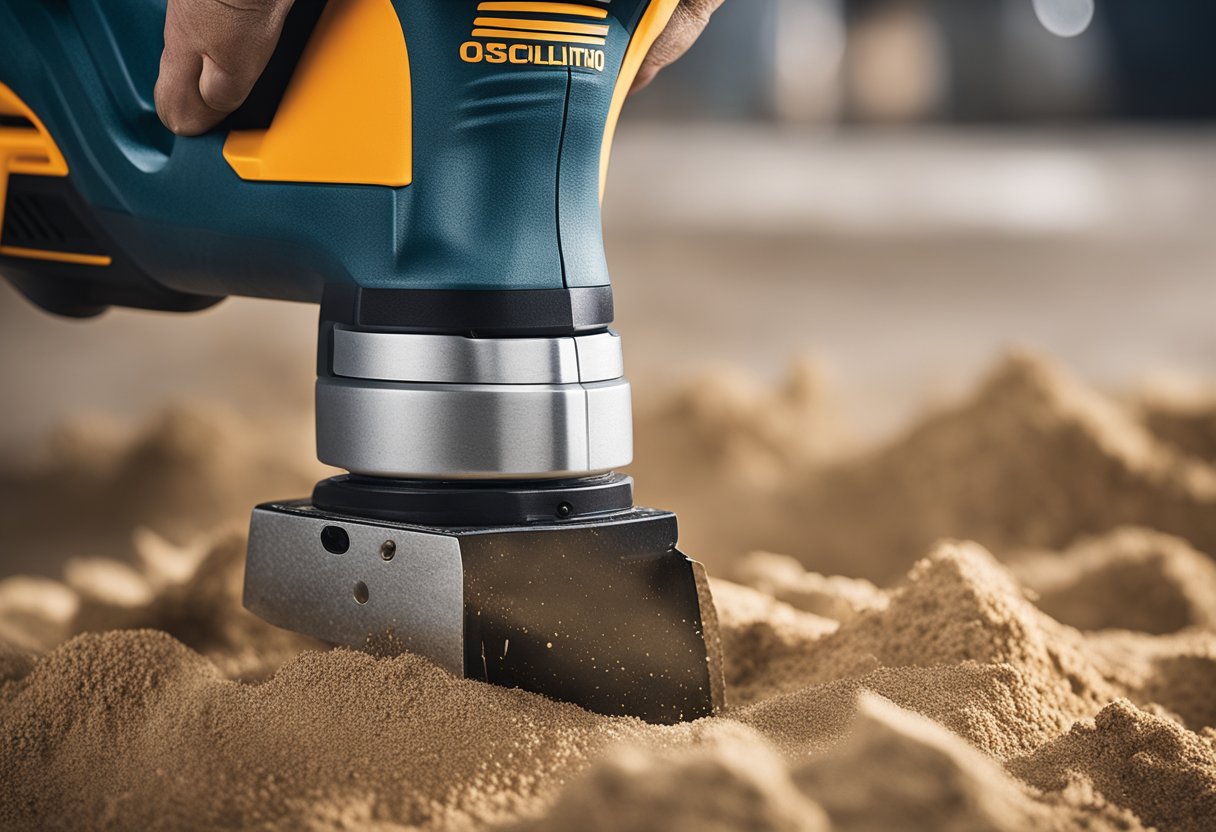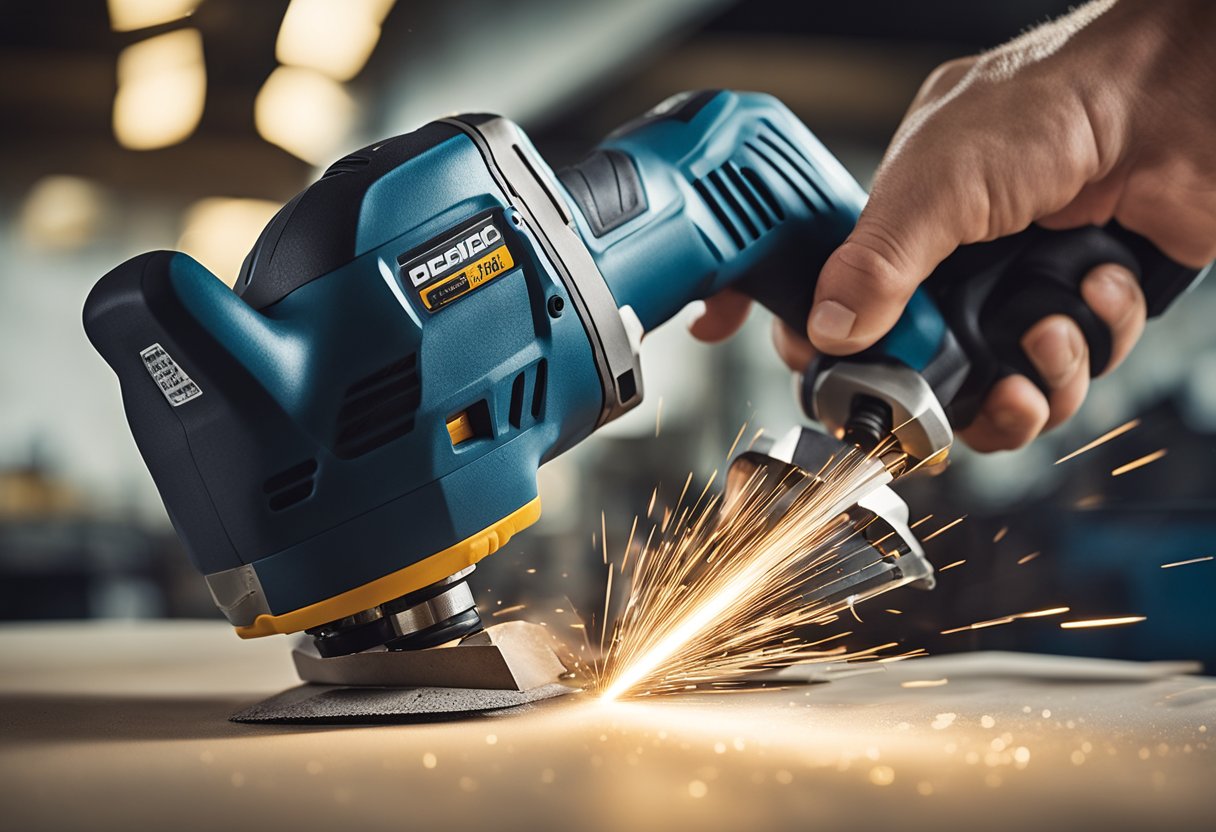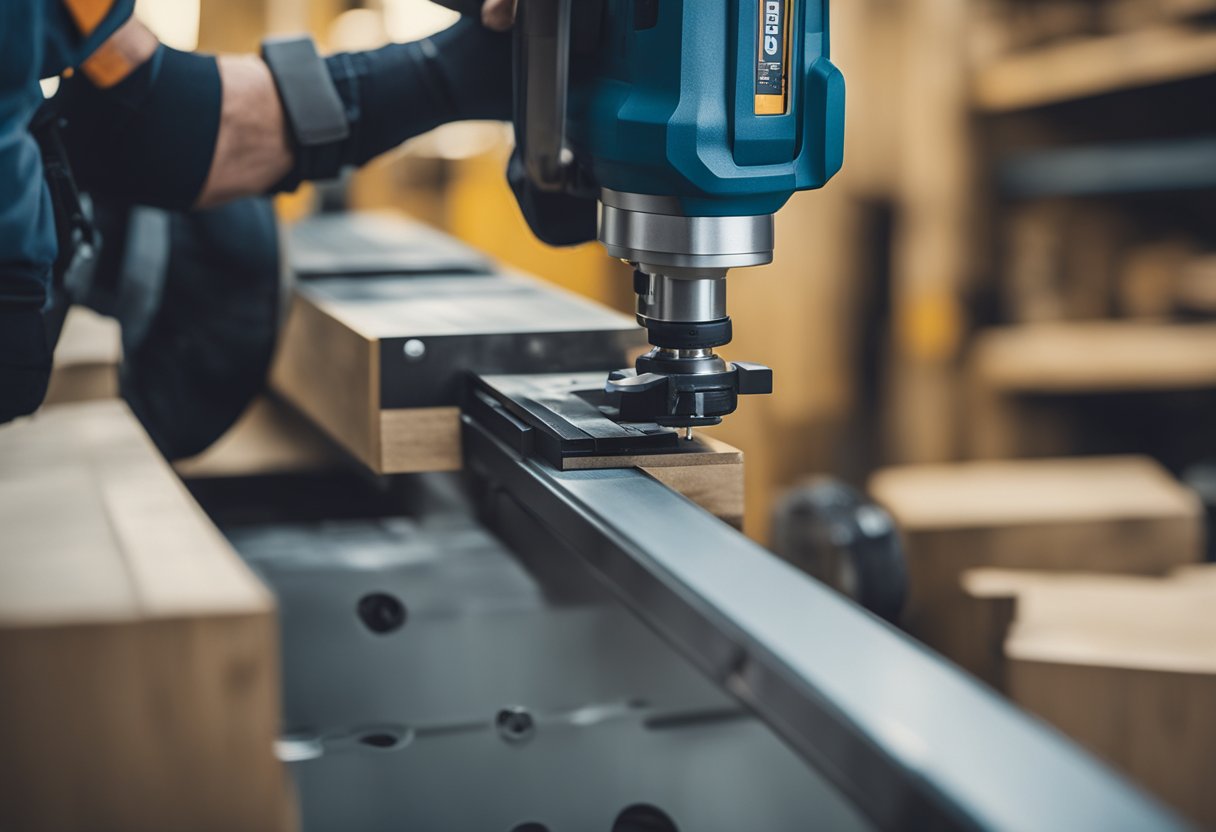Oscillating tools are versatile handheld power tools that can be used for a wide variety of DIY and professional tasks. These tools are designed to perform a range of cutting, sanding, scraping, and grinding tasks, making them an essential addition to any toolbox. But how exactly does an oscillating tool work, and what makes it so effective for so many different tasks?
At its core, an oscillating tool is a motorized power tool that moves a blade or other attachment back and forth at high speeds. This back-and-forth motion allows the tool to make precise cuts, sand surfaces, and scrape away materials with ease. The blade or attachment is mounted on a special mounting plate that allows it to move in a specific pattern, depending on the task at hand.
One of the key advantages of oscillating tools is their ability to work in tight spaces where other power tools simply can’t fit. This makes them ideal for tasks like cutting out electrical boxes in drywall, sanding in corners, and removing grout from tight spaces. With the right blade or attachment, an oscillating tool can perform a wide range of tasks quickly and easily, making it a must-have tool for any DIY enthusiast or professional contractor.
Key Takeaways
- Oscillating tools are handheld power tools that move a blade or attachment back and forth at high speeds to perform a range of tasks.
- These tools are ideal for working in tight spaces and can be used for cutting, sanding, scraping, and grinding tasks.
- With the right blade or attachment, an oscillating tool can perform a wide range of tasks quickly and easily, making it an essential addition to any toolbox.
Understanding Oscillating Tools
https://www.youtube.com/watch?v=Om4Nz-o3V6E&embed=true
Oscillating tools are handheld power tools that are versatile and efficient. They are also known as oscillating multi-tools or oscillating multitools. They are designed to perform a wide range of tasks such as cutting, sanding, grinding, scraping, and polishing various materials such as wood, metal, plastics, and ceramics.
The oscillating tool works by delivering high-speed oscillating movement to a flat or curved blade. The blade moves back and forth at a very high frequency, which allows it to cut through materials with ease. The oscillating movement is very slight, usually around 3 degrees, and very fast, around 20,000 strokes per minute.
One of the main advantages of oscillating tools is their compact and lightweight design. This makes them easy to handle and maneuver in tight spaces. They are also very powerful, which allows them to perform tasks quickly and efficiently.
Oscillating tools are commonly used in DIY projects and home improvement tasks. They are also used by professionals in various industries such as construction, woodworking, and automotive repair.
When selecting an oscillating tool, it is important to consider the power and speed of the tool. Higher power and speed will allow the tool to perform more efficiently and effectively. Additionally, tool-free blade change and mounting plate are also important features to look for when selecting an oscillating tool.
Overall, oscillating tools are versatile and efficient power tools that are suitable for a wide range of tasks. They are easy to use and handle, making them a popular choice among DIY enthusiasts and professionals alike.
Types of Blades and Attachments
As I mentioned earlier, an oscillating tool is a versatile tool that can be used for various purposes. The tool head can be equipped with different types of blades and attachments depending on the task at hand.
Blades for Different Materials
Blades for oscillating tools come in different shapes, sizes, and materials, and they are designed to cut through different materials such as wood, metal, plastic, and tile. Carbide blades are ideal for cutting through tough materials such as metal, while metal cutting blades are perfect for cutting through softer materials such as wood and plastic.
Sanding and Scraping Attachments
Sanding pads and scrapers are also popular attachments for oscillating tools. Sanding pads come in different grits and are used for sanding and smoothing surfaces. Scrapers, on the other hand, are used for removing old paint, glue, and other materials from surfaces.
Grout Removal and Polishing Attachments
Grout removal and polishing attachments are also available for oscillating tools. Grout removal attachments are used for removing old grout from tiles, while polishing pads are used for polishing and grinding surfaces.
In conclusion, oscillating tools are versatile tools that can be used for various purposes. The type of blade or attachment you need depends on the task at hand. Carbide blades and metal cutting blades are ideal for cutting through tough and soft materials, respectively. Sanding pads and scrapers are perfect for sanding and smoothing surfaces, while grout removal and polishing attachments are used for removing old grout and polishing surfaces.
Cutting and Sawing with Oscillating Tools
https://www.youtube.com/watch?v=RZcXy6-llXs&embed=true
An oscillating tool is a versatile handheld power tool that can perform a variety of tasks, including cutting, sanding, grinding, scraping, and polishing. In this section, I will discuss how to use an oscillating tool for cutting and sawing.
Straight and Plunge Cuts
One of the most common uses for an oscillating tool is making straight cuts. To do this, you will need a straight blade attachment. Simply attach the blade to the tool and adjust the depth of cut to your desired thickness. Then, hold the tool firmly and make your cut. The oscillating motion of the blade allows for precise cuts, even in tight spaces.
Another type of cut you can make with an oscillating tool is a plunge cut. This is useful for cutting holes in the middle of a piece of material, such as for installing electrical boxes or cutting out damaged sections of drywall. To make a plunge cut, you will need a plunge-cutting blade attachment. With the blade attached, set the depth of cut to the thickness of the material you are cutting. Then, plunge the blade into the material and make your cut.
Cutting Various Materials
An oscillating tool can cut through a variety of materials, including wood, metal, plastic, and copper. When cutting wood, use a wood-cutting blade attachment. For metal, use a metal-cutting blade attachment. For plastic, use a plastic-cutting blade attachment. And for copper pipes, use a copper-cutting blade attachment.
When cutting any material, it is important to select the appropriate blade attachment for the job. Using the wrong blade can result in poor performance and even damage to the tool or the material being cut.
In addition to selecting the right blade attachment, it is also important to adjust the depth of cut to the thickness of the material being cut. This will ensure that the blade cuts cleanly and efficiently without bogging down the tool.
Overall, an oscillating tool is a versatile and useful tool for cutting and sawing. With the right blade attachment and a little practice, you can make precise cuts in a variety of materials.
Sanding and Scraping Tasks
When it comes to sanding and scraping tasks, oscillating multi-tools are versatile and efficient. They can perform various functions, including sanding wood and metal, as well as scraping paint and caulk. In this section, I will discuss how oscillating multi-tools work for sanding and scraping tasks, and what attachments can be used for these jobs.
Sanding Wood and Metal
Sanding is a common task when it comes to woodworking and metalworking. Oscillating multi-tools can make sanding jobs more comfortable and efficient. They work by oscillating the sanding pad at high speeds, which helps to remove material quickly and smoothly. Sanding pads come in different shapes and sizes, allowing you to sand various surfaces, including corners and edges.
When sanding wood, it is best to start with a coarse sanding pad and work your way up to a finer grit. This will help to remove any rough spots and leave a smooth finish. When sanding metal, it is essential to use a sanding pad that is designed for metal, as metal can be more challenging to sand than wood.
Scraping Paint and Caulk
Removing paint and caulk can be a tedious and time-consuming task. Fortunately, oscillating multi-tools can make this job easier. They work by oscillating the scraping blade at high speeds, which helps to remove paint and caulk quickly and efficiently.
When scraping paint, it is essential to use a scraping blade that is designed for this purpose. Some scraping blades have a serrated edge that can help to remove paint more effectively. When scraping caulk, it is best to use a flexible scraping blade that can conform to the shape of the surface.
In conclusion, oscillating multi-tools are versatile and efficient tools that can perform various sanding and scraping tasks. Whether you are sanding wood or metal, or removing paint and caulk, oscillating multi-tools can make these jobs easier and more efficient. By using the right attachments, such as sanding pads and scraping blades, you can achieve a smooth finish and remove material quickly and effectively.
Working in Tight Spaces
https://www.youtube.com/watch?v=cqfZXAnh7As&embed=true
When it comes to working in tight spaces, an oscillating tool is your best friend. Its compact size and versatile attachments allow you to reach tight spaces with ease. Whether you need to make precise cuts in door jambs or sand tight angles, an oscillating tool can get the job done.
One of the most useful attachments for working in tight spaces is the flush-cut blade. This blade allows you to make precise cuts without damaging surrounding materials. It’s perfect for cutting doorjambs or baseboards to fit new flooring or for trimming pipes and nails.
Another attachment that comes in handy when working in tight spaces is the sanding pad. With its small size, you can sand tight angles and corners with ease. It’s also great for sanding small areas of wood or metal.
When working in tight spaces, it’s important to pay attention to the oscillating angle of the tool. The larger the angle, the more aggressive the tool. Most oscillating tools have a fixed side-to-side motion between 2° and 5°, which is perfect for precise cuts in tight spaces.
In conclusion, an oscillating tool is an essential tool for anyone who needs to work in tight spaces. With its compact size and versatile attachments, you can reach tight spaces with ease and make precise cuts and sanding in door jambs, angles, and other tight areas.
Advanced Features and Controls
As an oscillating tool user, I find it important to understand the advanced features and controls that come with this versatile power tool. These features not only enhance the performance of the tool but also make it easier to use.
One of the most important features of an oscillating tool is speed control. This feature allows me to adjust the speed of the tool according to the task at hand. For instance, when I need to make precise cuts, I can lower the speed of the tool to avoid damaging the material I am working on. On the other hand, when I need to remove tough grout or sand a large surface area, I can increase the speed of the tool for more efficient results.
Another feature that I find useful is cordless operation. With cordless oscillating tools, I can work in areas without a power source, making it easier to work on outdoor projects or in remote locations. The battery life of cordless oscillating tools has improved significantly over the years, and I can now work for hours on a single charge.
When it comes to batteries, I prefer lithium-ion batteries because they offer a longer runtime and a shorter charging time. Moreover, lithium-ion batteries are lighter and more compact than other battery types, making them more convenient to use.
Heat is a common issue when using power tools, and oscillating tools are no exception. Overheating can cause damage to the tool and reduce its lifespan. To avoid this, I make sure to use the oscillating tool at the correct speed and apply moderate pressure. I also take breaks when necessary to allow the tool to cool down.
Finally, the versatility of an oscillating tool is unmatched by other power tools. With the right accessories, an oscillating tool can perform a variety of tasks, from cutting and sanding to grinding and scraping. This makes it a valuable addition to any DIY enthusiast or professional’s toolkit.
In conclusion, understanding the advanced features and controls of an oscillating tool is crucial for achieving the best results and prolonging the tool’s lifespan. With speed control, cordless operation, lithium-ion batteries, heat management, and versatility, an oscillating tool can handle a wide range of projects with ease.
Safety Considerations and Best Practices
When working with an oscillating tool, safety should always be the top priority. Here are some best practices to keep in mind:
- Wear protective gear: Always wear safety goggles, a dust mask, and gloves when using an oscillating tool. This will protect your eyes, lungs, and hands from debris and dust.
- Use the right blade: Make sure you are using the correct blade for the job. Using the wrong blade can result in poor performance and can be dangerous.
- Secure your workpiece: Always clamp or secure your workpiece to prevent it from moving during use. This will help prevent accidents and ensure accuracy.
- Keep your workspace clean: Keep your workspace clean and free of clutter to prevent tripping hazards and accidents.
- Use proper technique: Use proper technique when using an oscillating tool. Keep the tool at a 90-degree angle to the workpiece and avoid applying too much pressure. Let the tool do the work.
- Avoid using the tool in hazardous areas: Do not use the oscillating tool in areas where there is a danger of explosion or flammable materials. Sparks can be produced that can ignite combustible materials.
By following these best practices, you can ensure that you are using your oscillating tool safely and effectively. Remember to always read the user manual and follow the manufacturer’s instructions for your specific tool.
Frequently Asked Questions
How does an oscillating tool cut through different materials?
An oscillating tool uses a side-to-side oscillating motion to cut through different materials. The tool’s blade or attachment moves back and forth at a very high speed, allowing it to cut through materials such as wood, metal, and plastic with ease. The oscillating motion of the tool ensures that the blade stays in contact with the material being cut, resulting in clean and precise cuts.
What types of blades or attachments can be used with an oscillating tool?
There are a variety of blades and attachments that can be used with an oscillating tool, including cutting blades, sanding pads, scrapers, and grinding attachments. The type of blade or attachment used will depend on the specific task at hand. For example, a cutting blade may be used to cut through wood or metal, while a sanding pad may be used for sanding or polishing surfaces.
Can an oscillating tool be used for sanding or polishing?
Yes, an oscillating tool can be used for sanding or polishing surfaces. Sanding pads and polishing attachments can be used with the tool to sand or polish surfaces such as wood, metal, or plastic. The oscillating motion of the tool ensures that the sanding or polishing pad stays in contact with the surface, resulting in a smooth and even finish.
What safety precautions should be taken when using an oscillating tool?
When using an oscillating tool, it is important to wear appropriate safety gear, such as safety glasses and gloves. It is also important to ensure that the tool is properly grounded and that the blade or attachment is securely attached to the tool. Additionally, the tool should be turned off and unplugged when changing blades or attachments.
How does the oscillating motion of the tool differ from other power tools?
The oscillating motion of an oscillating tool is unique compared to other power tools. While other power tools, such as circular saws or jigsaws, use a rotating motion to cut through materials, an oscillating tool uses a side-to-side oscillating motion. This motion allows the tool to make precise cuts without damaging surrounding materials.
What are some common applications for an oscillating tool?
An oscillating tool is a versatile tool that can be used for a wide range of applications. Some common applications include cutting through wood or metal, sanding or polishing surfaces, removing grout, and scraping away old paint or adhesive. The tool’s ability to use a variety of blades and attachments makes it a must-have tool for DIY enthusiasts and professionals alike.

Hi, I’m Sal Muller of Tooltrip.com. My DIY experience led me to understand essential power tools for home projects. Tooltrip.com guides enthusiasts and professionals in choosing right tools for any job. I provide concise top tool reviews for easier, efficient DIY.







